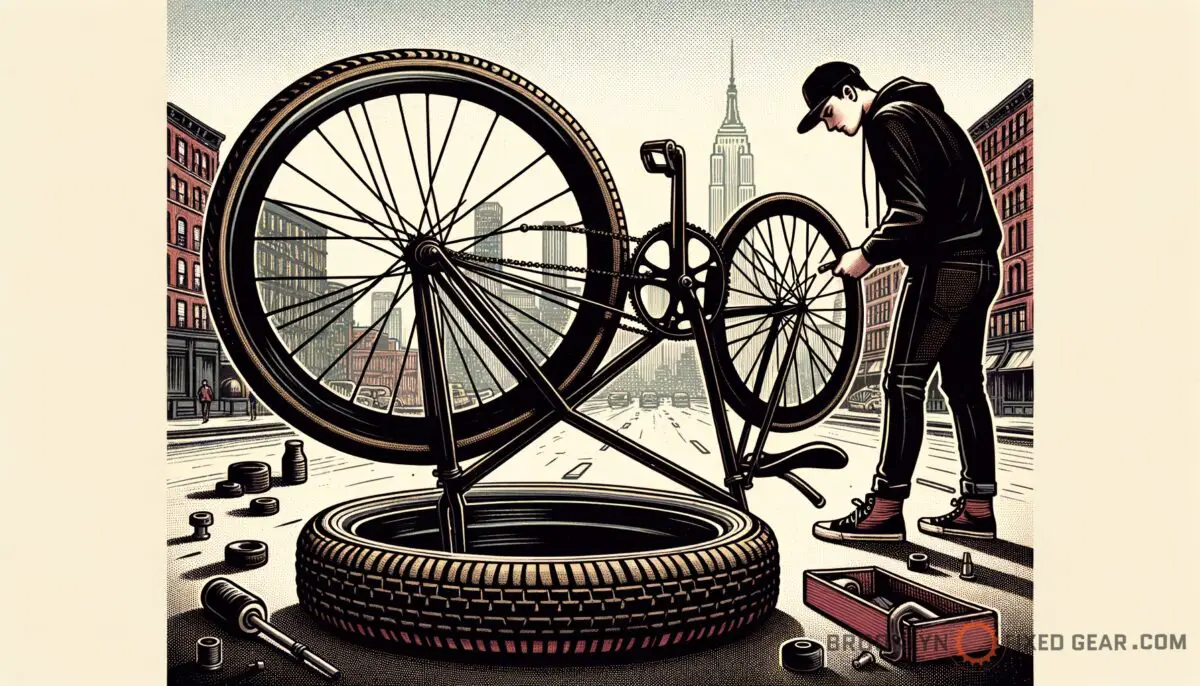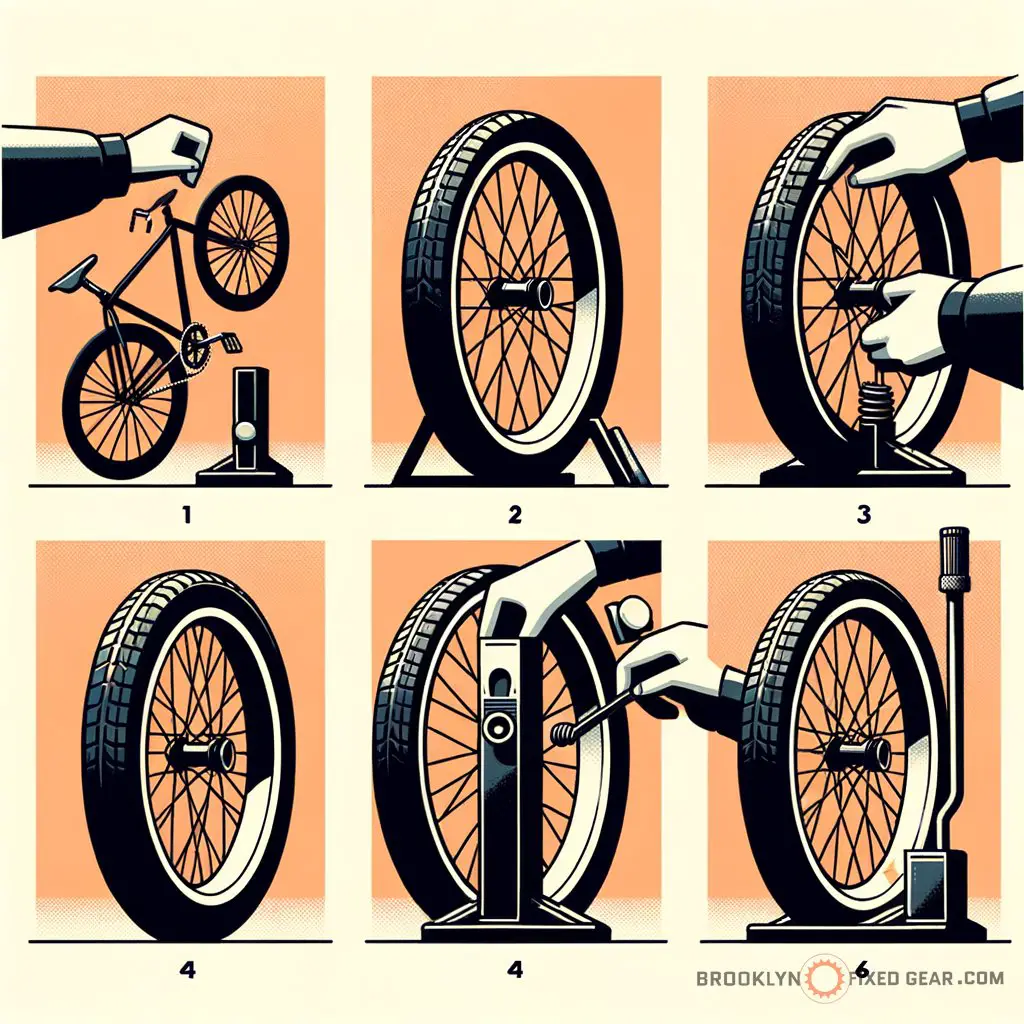Ever had that feeling when you’re all set for a ride, but a flat tire deflates your spirits? Yeah, it’s a buzzkill for any cyclist, especially when you’re gearing up to cruise on one of the best fixie bikes in town. But worry not!
Ever wondered how to install an inner tube and tire on your bike? I’ll break it down for you step-by-step. It’s an essential skill that can get you rolling again in no time.
If you are a visual learner, check out this video titled ‘Installing a new bike tire and inner tube in 5 minutes’
In this post, you’ll learn the ins and outs of inner tube and tire installation to keep your ride smooth.
Key takeaways
- Check the inside of the tire for sharp objects to prevent future flats.
- Use the proper tools like tire levers and a suitable pump.
- Regularly inspect tires for wear and ensure proper tire pressure.
How to install an inner tube and tire on a bike
Installing an inner tube and tire on your fixie or single-speed ride is as crucial as the slick moves you pull on the streets. It’s not rocket science, but it does require some finesse and the right technique to ensure you’re back pedaling with no hiccups. Let’s dive into the process so you can handle flats like a pro.

Step 1: Prep your bike
Before you start, make sure your bike is stable. Flip it over so it rests on the seat and handlebars or prop it up on a bike stand if you’ve got one. Then, remove the wheel from your bike.
If you’ve got rim brakes, you’ll need to release them to get the wheel out smoothly.
Step 2: Remove the tire and tube
Use a tire lever to pry under the tire’s bead and hook it onto a spoke. Work the lever around the rim to ease the tire off. Once you’ve got one side free, remove the old inner tube.

Remember, patience is key here; you don’t want to nick the tire or tube.
Step 3: Check for sharp objects
Now take a moment to feel inside the tire for any sharp objects that might’ve caused the flat. Run your fingers around the entire inside surface. If you find anything, remove it.
Skipping this step could lead to another flat, and let’s be honest, that’s the last thing you want.
Step 4: Insert the new inner tube
Slightly inflate your new inner tube so it holds its shape, making it easier to fit inside the tire. Start by inserting the valve through the rim’s valve hole, then carefully work the tube into the tire all around the wheel.
Step 5: Fit the tire onto the rim
Start at the valve and push the bead of the tire back under the rim edge, working your way around. You might be able to do this with your hands, or you might need those tire levers again. Be gentle; a pinched inner tube is like a bad joke that falls flat.

Step 6: Inflate the tire to the right pressure
Consult your tire sidewall or a trusted source for the correct tire pressure for your ride and inflate accordingly. This is crucial for performance and avoiding pinch flats or blowouts.
Step 7: Reinstall the wheel
Align the wheel back in the frame or fork. Make sure it’s centered, with the tire not rubbing against the frame or brakes. Tighten the bolts or cam lever securely, and you’re just about ready to hit the road again.
State Bicycle Co. Black Label 6061

State Bicycle Co. Black Label 6061
More installation tips
When you’re installing an inner tube and tire, the devil’s in the details. These tips aren’t just icing on the cake; they’re more like the secret sauce that’ll make the whole process smoother. Keep them in your back pocket for a hassle-free installation.
- Ensure your tire levers are made of plastic to avoid damaging the rim or tire.
- Always carry a spare inner tube, tire levers, and a portable bike pump or CO2 inflator during rides.
- Consider using tire liners or a sealant to prevent future flats – it’s like a shield for your tubes.
- Regularly inspect your tires for wear and tear to avoid getting caught with a flat at the worst possible time.
When it comes to the dos and don’ts of installing inner tubes and tires, some things should be as second nature as your morning coffee while others are a definite no-go.
| Do | Don’t |
|---|---|
| Do check the tire diameter and width before buying. | Don’t ignore the tire’s rotation direction. |
| Do use just enough force when using tire levers. | Don’t inflate beyond the recommended psi. |
| Do make sure the tire bead is seated evenly. | Don’t rush the installation process. |
| Do re-check for sharp objects if you get repeated flats. | Don’t leave creases or twists in the inner tube. |
Always confirm the tire bead’s even seating by inspecting around the rim.
Advantages and disadvantages of installing an inner tube and tire
Ready to roll up your sleeves and get your hands dirty? Installing your own inner tube and tire comes with benefits and drawbacks. Let’s puncture the mystery and see what the trade-offs are.
Advantages
- Saves you a trip to the bike shop and some cash for other cycling gear.
- Hands-on experience improves your understanding of your bike’s mechanics.
- It’s empowering being able to fix your own ride.
Disadvantages
- Without proper equipment, it can be frustrating and time-consuming.
- There’s a risk of improper installation, which could lead to more flats or a damaged wheel.
- You could injure yourself trying to pry on a stubborn tire — those tire levers aren’t as friendly as they look.
“It’s not rocket science, but installing an inner tube and tire does require some finesse and the right technique. Remember, patience and the proper method can save you from the frustration of a flat when you’re ready to roll.”
In my opinion, as someone who isn’t a professional mechanic but a keen cyclist, tackling your own tire and tube installation can be a rewarding experience. It gives you a hands-on understanding of your ride that no shop can offer. Sure, the first couple of times can be tricky, and you might second-guess your technique, but once you nail it, it’s a set of skills that sticks with you on every ride.
Plus, it’s a great way to bond with your bike — yeah, that’s a thing.
I’ve got to say, though it’s not for everyone, especially if you’re prone to frustration or short on time. There’s no shame in leaving it to the pros at your local bike shop. Still, for those looking to dive a bit deeper into their cycling hobby, becoming self-sufficient with these kinds of repairs can be a real game-changer.
If you’re curious about doing more than just riding, check out some tricks and performance tips for a fixie to add a new dimension to your cycling experience.
Frequently asked questions (FAQ)
Is a puncture repair kit necessary?
Even if you know how to install an inner tube and tire, a puncture repair kit is a smart addition to your arsenal. Instead of replacing the tube, you can simply patch it up, saving you money and making you more self-reliant on longer rides.
Do I need special tools to install a bike tire?
You’ll need a set of tire levers and a pump at the very least. Some might prefer a bead jack for tight tires, and a valve core tool can be handy if you’re using tubeless setups.
How usually should I replace my bike tires?
It depends on your riding conditions and tire quality, but keep an eye out for worn treads, frequent flats, or damaged sidewalls. As a general rule, replacing your tires every 2,000 to 3,000 miles is a good practice to ensure optimal performance and safety.
Final thoughts
Now that you’ve got the lowdown on changing an inner tube and tire, you’re well on your way to becoming a self-sufficient cyclist. With a bit of practice, you’ll find that installing a new tube or tire is a breeze. So gear up, grab your tools, and don’t let a flat hold you back from your next adventure on two wheels.
How has your experience been with changing your own tires and tubes? Did I cover everything you wanted to know? Let me know in the comments section belowI read and reply to every comment. If you found this article helpful, share it with a friend, and check out my full blog for more tips and tricks on bike maintenance. Thanks for reading and keep those wheels turning!















